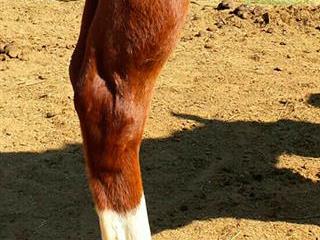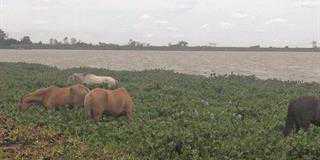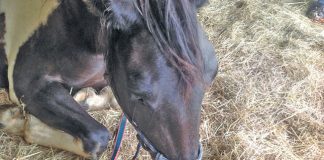
The tarsus (hock) of a horse is the joint between the tibia and the metatarsal (cannon) bone in the hind leg. If you look at a horse from the side, the point of the hock and the cannon bone should be in a straight line with the point of the hip.
If a horse has a sickle hock, the point of the hock is in line with the hip, but the cannon bone is angled so that the hoof is too far forward. In other words, the hind leg is slightly curved, like a sickle.
While true sickle hocks are caused by the bones in the hock being aligned at an acute angle, a long, sloped pastern or long toes on the hind hoof can give rise to a similar condition. A hip bone that tips forward can also result in a sickle hock. Diet, too, can play a role: an imbalance of proteins and minerals can cause bony deformities.
Whatever its root cause, this excessive bending causes strain on the hock joint and its tendons and ligaments. Curb, a chronic inflammation of the tendons at the back of the hock, is the most common complication. Another is bog spavin, a swelling just under the Achilles tendon.
Not all bad
The hock joint itself can also become inflamed, leading to acute swelling and pain with long-term bony changes, or arthritis. One form of this arthritis, which causes a bony lump on the inner surface of the leg, is called bone spavin.
Further up the leg, the acute angle of the hock can unbalance the stifle (the joint between femur and tibia); further down, it can cause problems in the fetlock and hoof bones. Although the list of complications sounds horrific, dressage and reining horse riders sometimes prefer a slightly sickle-hocked horse; it is easier to collect into frame as the centre of gravity is shifted slightly backwards.
Proper training
You can compensate for sickle hocks when you train a horse by not forcing it to work excessively on movements that stress the hock, such as rapid turns and stops in reining, flying changes, and piaffe in dressage horses. The training programme should have two phases. In the first, use trotting exercises (‘long trot’ in Western, ‘rising trot’ in dressage) to build muscle and get the horse fit. Avoid collection and turns as far as possible.
In the second phase, work for only a limited time on exercises where the hocks are actively engaged. Link the two phases with flexing exercises. A good farrier is essential. In a sickle-hocked horse, the hind hoof angles should be kept high (45° or more) and wedges might be needed between the hoof and shoe.
The toes can be shortened, using a blunt-toed shoe set back with a rolled toe, or a flat shoe with a rockered toe, to facilitate break-over and bring the hooves further backwards.
Long overgrown toes due to neglect can make a well-conformed horse appear to be sickle-hocked and have the same long-term effects on the joints. Although training and farriery can prevent the horse becoming unsound, sickle hocks are heritable, so horses with this conformation should not be used for breeding.
Dr Mac is an academic, a practising equine veterinarian and a stud owner.













